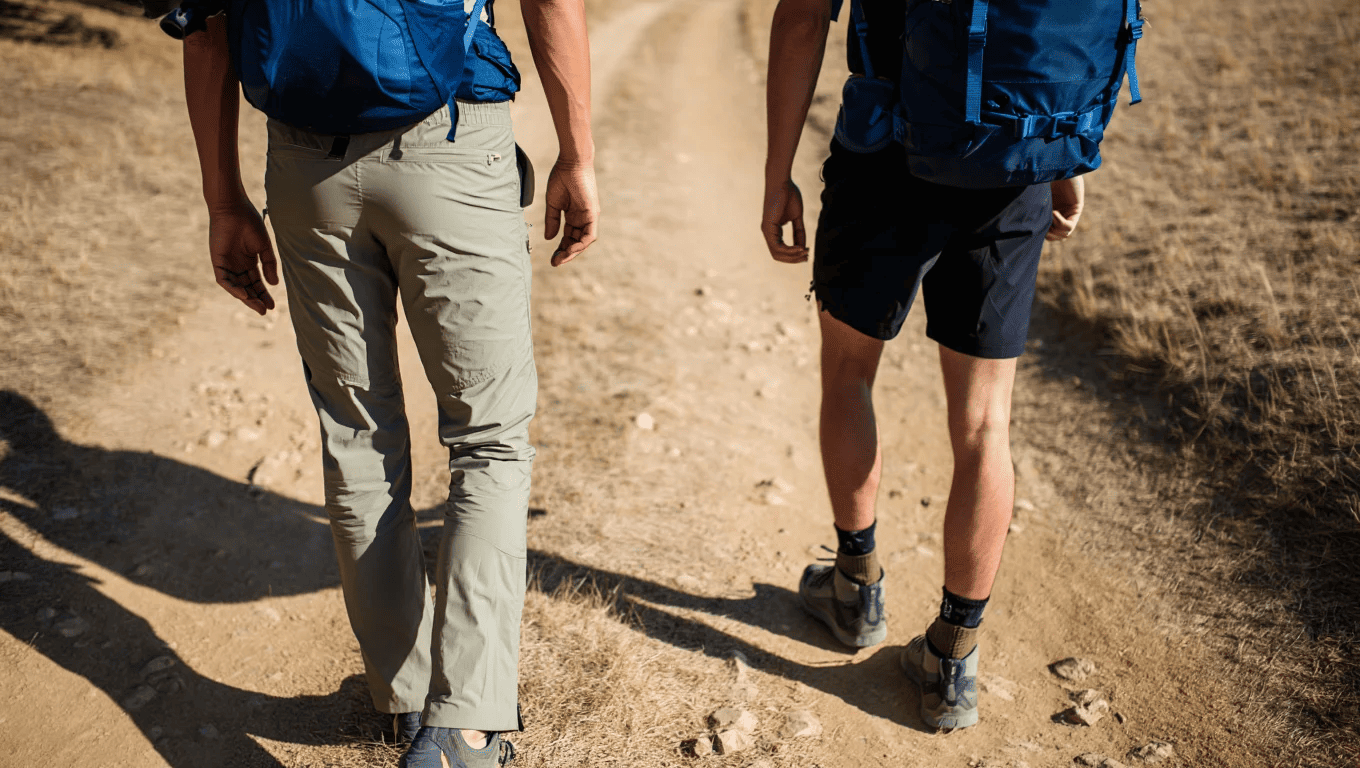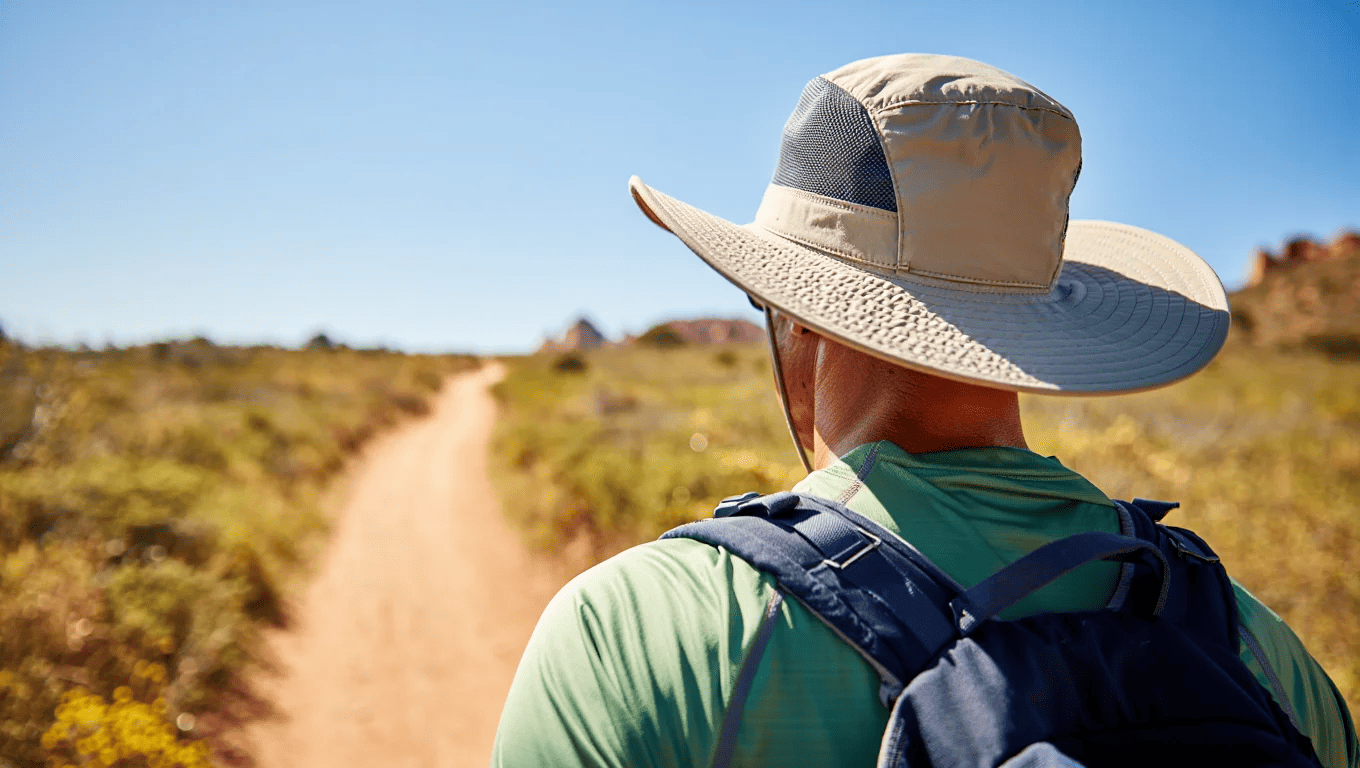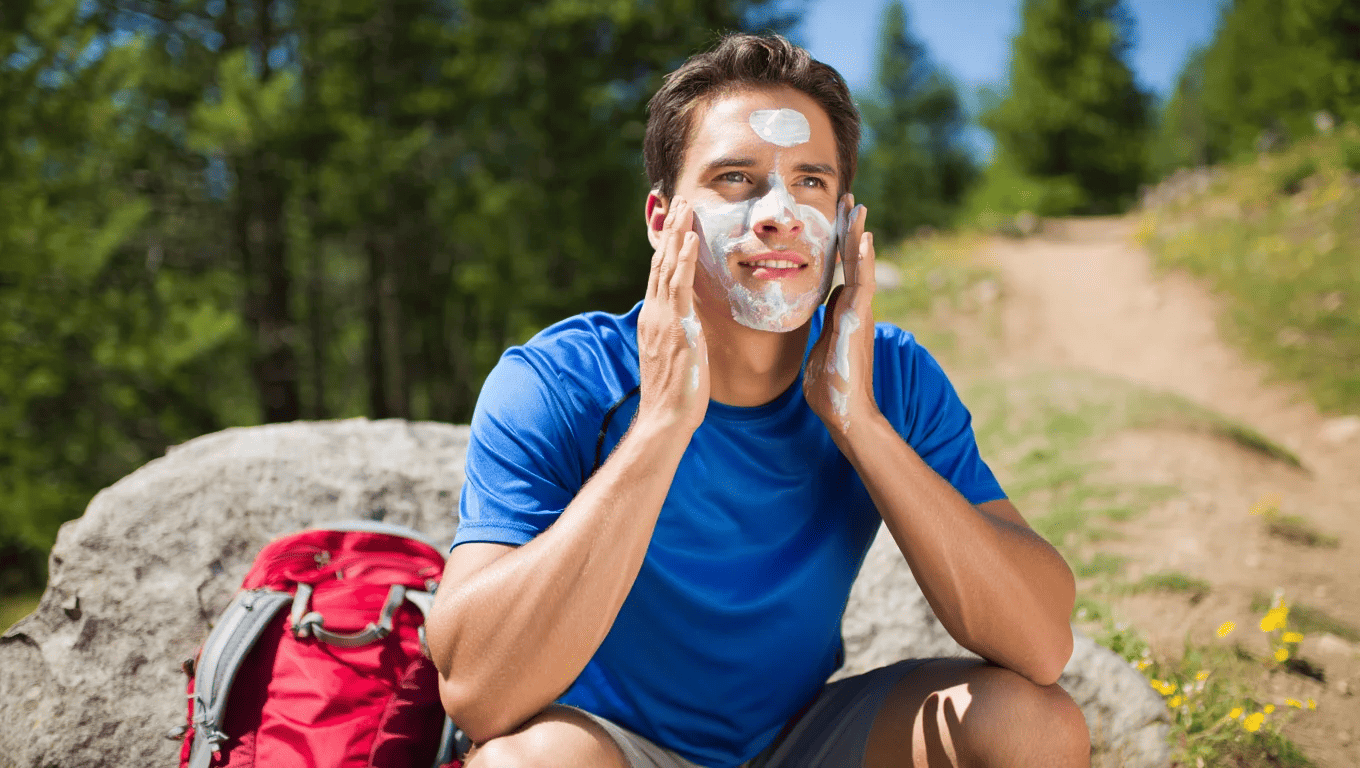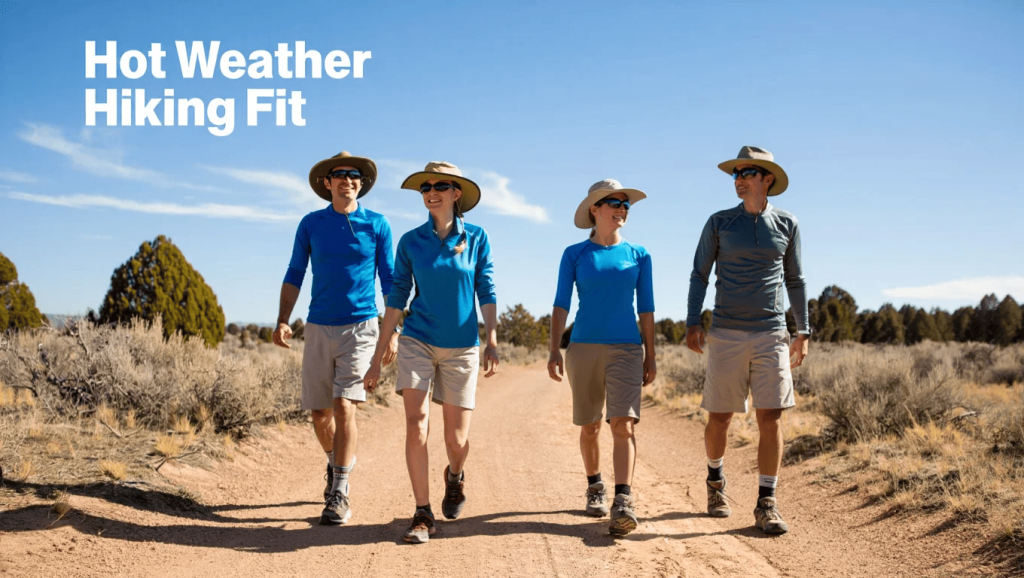Hiking in hot weather calls for smart clothing choices. The wrong outfit can make you too hot, sunburned, or even sick. The right clothes keep sweat moving away from your skin.
They protect you from the sun’s harmful rays. They help your body stay at a safe temperature. Light colors reflect heat instead of absorbing it. Special moisture-wicking fabrics pull sweat away from your body.
Proper coverage shields your skin from UV damage. All these elements work together to keep you comfortable on sunny trails. Even experienced hikers struggle when temperatures soar.
Heat can affect anyone, regardless of fitness level. Your body works harder in hot conditions. With the correct gear, you can still enjoy beautiful summer hikes without overheating.
Start with the Right Clothing Fabric
When hiking in hot weather, your clothing choice makes all the difference. Breathable, moisture-wicking fabrics actively pull sweat away from your skin, allowing it to evaporate and cool your body naturally.
This process helps regulate your temperature even when the mercury rises. Look for clothing with UPF (Ultraviolet Protection Factor) ratings, which block harmful UV rays much more effectively than regular fabrics – essential protection during long days on sun-exposed trails.
Opt for light colors like white, tan, or khaki that reflect rather than absorb the sun’s heat, helping you stay noticeably cooler throughout your hike.
While cotton might feel comfortable initially, it holds moisture and dries slowly, so synthetic materials like nylon or polyester are typically better choices for hot-weather trips.
The right fabric combination keeps you comfortable, protected, and helps prevent heat-related illnesses on challenging summer treks.
Footwear for Hot Weather Hiking

Your feet need special attention when hiking in hot conditions. Breathable footwear is crucial – trail runners offer maximum ventilation and are perfect for well-maintained paths, while hiking shoes balance breathability with protection for moderate terrain.
Traditional boots, though hotter, remain necessary for rough trails that demand ankle support. Never wear cotton socks, as they trap moisture and can cause blisters.
Instead, choose moisture-wicking materials like merino wool or synthetics that keep feet dry and comfortable. Merino wool is particularly effective as it regulates temperature and minimizes odor even in high heat.
Consider using thin sock liners underneath your hiking socks to create a friction barrier that prevents painful blisters, especially important when feet swell in hot weather. The right footwear combination can mean the difference between an enjoyable hike and a miserable experience with hot spots and sore feet.
Clothing Options for the Top Half
Your upper body clothing can make or break your hot-weather hiking experience. The right top layer helps manage sweat, provides sun protection, and keeps you comfortable throughout your trip.
Choose options based on your personal comfort and the specific conditions of your hike.
1. Tank Tops and Short-Sleeve Shirts

Tank tops and short-sleeve shirts offer maximum ventilation when hiking in extreme heat. They allow air to circulate freely around your torso and arms, helping sweat evaporate quickly.
Look for moisture-wicking synthetic fabrics like polyester or nylon rather than cotton, which stays wet and heavy. Many hiking-specific tops include features like antimicrobial treatments to prevent odor and flat seams to avoid chafing.
2. Long-Sleeve Shirts

Long-sleeve shirts provide excellent sun protection while still keeping you cool. Modern hiking shirts use lightweight, breathable fabrics with built-in UPF ratings of 30-50+ to block harmful UV rays.
Many feature roll-up sleeves, mesh venting panels under the arms, and collars that can be flipped up to protect your neck. These shirts are especially helpful on exposed trails with little natural shade.
3. Material Choices

The best fabrics for hot-weather hiking tops include synthetic blends and technical materials. Nylon and polyester dry quickly and wick moisture away from your skin.
Some hikers prefer the natural feel of lightweight merino wool, which regulates temperature and resists odors even after days of sweating. Avoid cotton completely as it absorbs sweat, dries slowly, and can cause chafing and discomfort during long hikes.
Bottoms: Pants or Shorts

Choosing between pants and shorts for hot-weather hiking isn’t as obvious as it might seem. Lightweight, quick-drying pants actually offer excellent protection from both sun and scratchy brush while helping you stay cool.
Look for pants with built-in UPF protection and ventilation features like mesh-lined pockets or side zippers that let heat escape. If you prefer shorts, consider models that hit just above the knee to protect your thighs while maintaining mobility on steep terrain.
Many hiking shorts include built-in liners to prevent chafing when you sweat. Both pants and shorts benefit from stretchy fabrics with gusseted crotches for unrestricted movement on challenging trails.
Regardless of your choice, avoid cotton and opt for nylon or polyester blends that dry quickly when wet. Some convertible pants with zip-off legs offer the best of both worlds, allowing you to adjust as conditions change throughout your hike.
Essential Sun Protection Accessories
Sun protection goes beyond just clothing when hiking in hot weather. The right accessories shield vulnerable areas like your face, eyes, and exposed skin from harmful UV rays.
These items are small to pack but make a huge difference in your comfort and safety on the trail.
1. Hats

A good hiking hat with a wide brim provides shade for your face, ears, and neck. Look for hats made from lightweight, breathable materials that include UPF protection and moisture-wicking sweatbands.
Many hiking hats feature mesh panels for ventilation and adjustable chin straps to keep them secure in windy conditions. A full-brimmed sun hat offers better protection than a baseball cap.
2. Sunglasses

Quality sunglasses protect your eyes from intense sunlight and harmful UV rays that can cause both short-term discomfort and long-term damage.
Choose polarized lenses that reduce glare, especially when hiking near water or snow. Look for wraparound styles that block light from the sides and are secured with a strap to prevent loss on challenging terrain.
3. Sunscreen

Apply broad-spectrum sunscreen with SPF 30 or higher about 15 minutes before starting your hike. Choose lightweight, sweat-resistant formulas specifically designed for active use.
Remember to reapply every two hours or more frequently if you’re sweating heavily. Don’t forget often-missed spots like the backs of your ears, neck, hands, and any skin exposed by your backpack straps.
Hydration and Cooling Essentials
Proper hydration and cooling are critical for safe hiking in hot weather. Having the right equipment helps you maintain your body temperature and prevent dehydration.
These items should be considered essential rather than optional when temperatures rise on the trail.
| ITEM | PURPOSE | RECOMMENDATION |
|---|---|---|
| Hydration Pack | Easy water access | 2- 3L bladder; promotes frequent sipping |
| Water Bottles | Backup water | Durable 1L bottles; easier to track consumption |
| Cooling Bandanas | Neck cooling | Soak in water; polymer versions stay cool longer |
| Neck Gaiters | Sun protection + cooling | UPF-rated; can be dampened for cooling |
| Electrolytes | Prevent hyponatremia | Tablets, powders, or sports drinks to replace salt |
| Spray Bottle | Create cooling mist | Small bottle for face/body cooling |
Remember to drink before you feel thirsty, as thirst is already a sign of mild dehydration. A good rule of thumb is to consume at least half a liter of water per hour in moderate temperatures, and up to one liter per hour in extreme heat.
Drinking small amounts frequently is better than large amounts infrequently.
Health and Safety Tips for Hot Weather Hiking

Hiking in hot weather demands extra precautions to prevent heat-related illnesses. Being prepared and recognizing warning signs can make the difference between an enjoyable hike and a dangerous situation.
- Hike early morning or late afternoon to avoid midday heat.
- Choose shaded trails whenever possible.
- Drink water regularly – about half a liter per hour.
- Watch for heat exhaustion signs: excessive sweating, dizziness, nausea.
- Rest immediately in the shade if feeling overheated.
- Apply cool water to the neck and wrists when overheated.
- Know when to turn back – prioritize safety over completing a trail.
Always inform someone of your hiking plans and expected return time. Even experienced hikers should respect the power of heat and never push beyond their physical limits in hot conditions.
Wrapping It Up
You don’t have to be uncomfortable when hiking in hot weather. The right clothes work like your personal cooling system. Light, breathable fabrics let air flow through. Sun protection keeps harmful rays away.
Your clothing choices directly affect how you feel on the trail. They also determine how safe you stay during hot hikes. Use these tips to build your hot-weather hiking outfit. Pay attention to how your body feels during your hike. Make adjustments based on your specific trail conditions.
Different temperatures may require slight changes to your gear. With the right gear, summer hiking becomes truly enjoyable. You won’t feel exhausted from fighting the heat.
Your focus can shift to the beautiful views around you. Nature becomes the star of your experience, not your clothing struggles. Stay cool, stay protected, and enjoy your summer hiking trips.
Visit us again for fresh travel inspiration, helpful guides, and expert tips.




